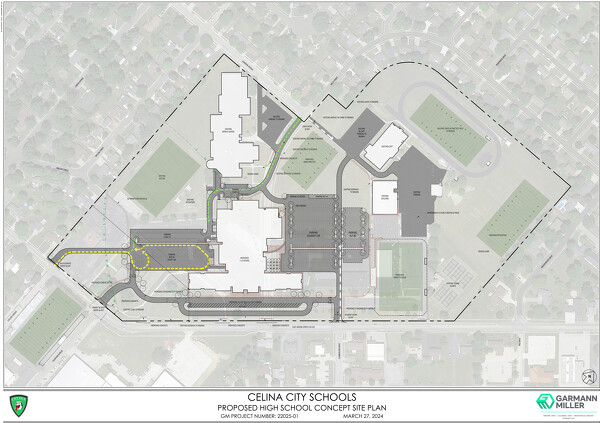
The proposed site plan concept for the new Celina High School.
CELINA - School board members have some tough choices to make in a relatively short time span as building project architect Garmann Miller recommends that all locally funded initiative (LFI) and master planning be completed by next March.
Garmann Miller officials at Monday night's regular school board meeting presented a detailed overview of decisions that need to be made about athletic facilities and fields and other structures related to the new grades 7-12 building and how much they will cost the district.
However, the general consensus of school officials was that not all facets of a master athletic plan will be implemented at once because of the high costs. Instead, they appeared to agree on the necessity of forming a roadmap for addressing athletic facilities, perhaps over a five to 15 year period.
Board members will have a better idea of the dollar amount they'll have to work with once bids for the new grades 7-12 buildings come in over the next few weeks. The bids should be ready for review by October's board meeting.
The budget for a new 202,800-square-foot middle school/high school is $78.36 million, according to Garman Miller officials.
"We have to look at the total cost of a lot of those things, not just the renovation because this difference is going to be paying for those buildings that we keep or we renovate for years to come," said board member Mark Huelsman. "We just have to wait until we get these final numbers, do the math and listen to the public and then make the right decision the best we can."
Board members had previously said they planned to hold public meetings to gauge the community's thoughts on future plans but did not set any dates on Monday night. While discussing how to engage the community, superintendent Brooke Gessler suggested contracting a third-party vendor to canvass taxpayers. No decision was made.
As far as the master plan goes, several items are already set in stone. The existing middle school building will remain and be reprogramed for other district needs. Same is the case for the CAPT Building.
The Tri Star addition of the current high school will stay, though its use is undetermined at this point. A auditeria/cafetorium with custom chairs containing backs and arms that retract like bleachers is incorporated in the design.
The existing tennis courts and varsity soccer field will remain where they are while the future track and field will be relocated to the northeast of the new grades 7-12 building.
One idea tossed about was the eventual establishment of an athletic campus to the northeast of the new school building. Critical decisions, though, must be made by next spring about the following items:
• The fieldhouse. The Ohio Facilities Construction Commission will co-fund the abatement and demolition of the field house and education complex building. The state recommends abatement and demolition due to the building's condition, but it's ultimately up to the district, according to Garmann Miller.
It would cost between $978,000 to $1.2 million to keep the fieldhouse. The estimate does not include any major renovations, enchantments or other upgrades.
• The varsity football field. There are multiple options for the eventual location of the football field. The first is to include it in the proposed track and field facility. This would cost between $2.2 million to $2.58 million and include 3,000 spectator home seats, 1,000 visitor seats, 500 north end-one seats, press box, scoreboard and goal posts.
This cost would come on top of the expense of creating a new track and field complex, which is pegged at $2.8 million to $3.5 million.
The next option would be to keep the varsity field at the existing football stadium with the fieldhouse. Garmann Miller puts the cost at $1.67 million to $1.95 million. The project would entail grandstand repairs, renovating wood bleachers with aluminum seats and other upgrades.
The fieldhouse would continue to be used for a ticket booth, restrooms, concessions and locker rooms.
There is also the option of keeping the varsity field at the existing football stadium without the fieldhouse at a cost of between $1.67 million to $1.95 million. New ticket booths, restrooms, concession stands, locker rooms and score board would add another $3.6 million to the bill.
• Tri Star addition on the north side of the existing high school. One proposal is to repurpose the structure as an athletic support building for concessions, large group and family restrooms, referee changing room/restroom, wrestling practice room, athletic storage and visitor locker room.
Garmann Miller projects this would cost between $1.5 million to $1.9 million. However, this would come in addition to other work necessary to secure the basic functionality of the Tri Star addition, which is estimated at $473,000.
• Location of varsity soccer games. The first option is keep play at the existing soccer field location. It would cost as much as $60,000 to install additional walkways and revise gate locations and the ticket booth, per Garmann Miller's presentation.
Option two is to carve out a new soccer field west of the existing tennis courts, a proposal estimated at between $1.47 million to $1.844 million.
A final option would be to relocate a new soccer field inside the proposed new track and field. This option would essentially cost nothing but the width of the field would be less than the existing soccer field, yet still within OHSAA's recommended regulations.
• Type of turf. Upgrading to artificial field turf at athletic locations would cost upwards of $965,000. Artificial turf would provide a consistent playing surface with minimal concerns of weather-related delays and cancelations. However, some feel artificial turf causes more injuries than natural grass.
The school board meets next at 6 p.m. Oct. 21 in the high school lecture hall.


